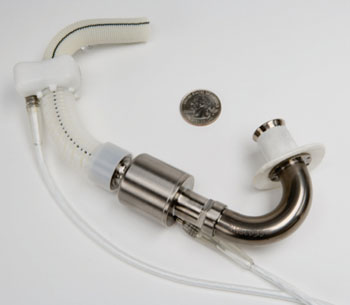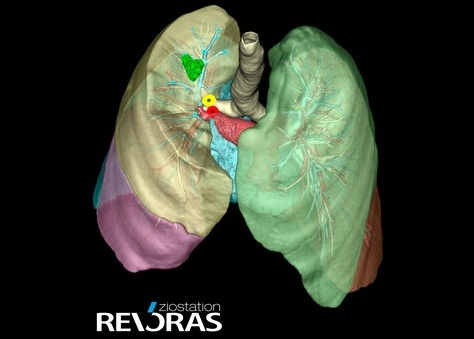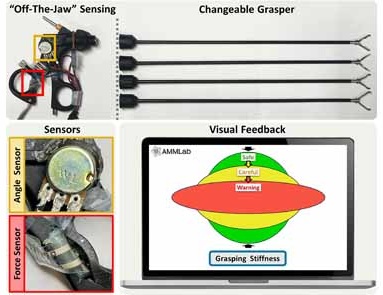Implantable Pump Helps the Failing Heart 
|
By HospiMedica International staff writers Posted on 14 Jul 2014 |

Image: The HeartAssist5 ventricular assist device (Photo courtesy of ReliantHeart).
A next generation ventricular assist device (VAD) offers natural human pulse circulation support to the weakened heart.
The HeartAssist5 VAD, which weighs just 92 grams, can support patients ranging from large adults to pediatric patients as small as 18 kg, providing a smooth, gentle blood flow from 2–10 L/min. Due to its small size, the device be implanted beside the heart, above the diaphragm, usually obviating the need to create a surgical pocket. As a result, the implantation procedure is safer, less complicated, and recovery time is reduced. The smaller size can also help to avoid many of the complications that contribute to blood sheer caused by non-human surface contact, and by the stresses caused by cavitation as blood flows through larger devices.
The only moving part of the device is the inducer/impeller, which has a major impact on blood-handling characteristics. Together with flow straightener and diffuser, the HeartAssist5 draws blood more smoothly, resulting in less damage to fragile components, including less platelet activation, which ultimately means patients require less anticoagulation medication. An implantable ultrasonic flow probe positioned on the outflow graft provides FlowAccurate diagnostics of the volume and fluidity of blood flow. Changes to this data can indicate problems ranging from minor dehydration to more significant events, alerting technicians as to early intervention.
HeartAssist5 includes the HeartAssistRemote Monitoring System, which continuously receives and transmits patient data via the vadlink.com website to expert clinicians. The data can be viewed remotely, avoiding unnecessary trips to the hospital. The data is also available via HeartAttendant, an all-in-one portable in-hospital console for the HeartAssist5. The HeartAttendant shows real time blood flow data, and transmits flow and other related data via secure wireless internet for remote home monitoring via computers or smartphones.
When discharged from the hospital, the Conquest Controller provides transmission of real-time remote HeartAssist5 data. The small controller fits in the pocket and transmits blood flow and related data via a secure wireless 3G cellular internet connection for remote monitoring. The HeartAssist5, HeartAttendant, and Conquest Controller are products of ReliantHeart (Houston, TX, USA), and have received the European Community CE marking of approval.
“If a patient’s pump has any sign of a challenge, like dehydration or low flow, the remote monitoring system signals the change to a data-collection center that notifies the transplant center as well as the individual,” said Rodger Ford, CEO of ReliantHeart. “This is what makes the HeartAssist5 unique; at the first sign of a problem the right people are notified immediately.”
Related Links:
ReliantHeart
The HeartAssist5 VAD, which weighs just 92 grams, can support patients ranging from large adults to pediatric patients as small as 18 kg, providing a smooth, gentle blood flow from 2–10 L/min. Due to its small size, the device be implanted beside the heart, above the diaphragm, usually obviating the need to create a surgical pocket. As a result, the implantation procedure is safer, less complicated, and recovery time is reduced. The smaller size can also help to avoid many of the complications that contribute to blood sheer caused by non-human surface contact, and by the stresses caused by cavitation as blood flows through larger devices.
The only moving part of the device is the inducer/impeller, which has a major impact on blood-handling characteristics. Together with flow straightener and diffuser, the HeartAssist5 draws blood more smoothly, resulting in less damage to fragile components, including less platelet activation, which ultimately means patients require less anticoagulation medication. An implantable ultrasonic flow probe positioned on the outflow graft provides FlowAccurate diagnostics of the volume and fluidity of blood flow. Changes to this data can indicate problems ranging from minor dehydration to more significant events, alerting technicians as to early intervention.
HeartAssist5 includes the HeartAssistRemote Monitoring System, which continuously receives and transmits patient data via the vadlink.com website to expert clinicians. The data can be viewed remotely, avoiding unnecessary trips to the hospital. The data is also available via HeartAttendant, an all-in-one portable in-hospital console for the HeartAssist5. The HeartAttendant shows real time blood flow data, and transmits flow and other related data via secure wireless internet for remote home monitoring via computers or smartphones.
When discharged from the hospital, the Conquest Controller provides transmission of real-time remote HeartAssist5 data. The small controller fits in the pocket and transmits blood flow and related data via a secure wireless 3G cellular internet connection for remote monitoring. The HeartAssist5, HeartAttendant, and Conquest Controller are products of ReliantHeart (Houston, TX, USA), and have received the European Community CE marking of approval.
“If a patient’s pump has any sign of a challenge, like dehydration or low flow, the remote monitoring system signals the change to a data-collection center that notifies the transplant center as well as the individual,” said Rodger Ford, CEO of ReliantHeart. “This is what makes the HeartAssist5 unique; at the first sign of a problem the right people are notified immediately.”
Related Links:
ReliantHeart
Latest Critical Care News
- First-Of-Its-Kind AI-Powered Probability Scoring System Assesses Heart Failure with Preserved Ejection Fraction
- AI-Assisted Colonoscopy Detects More Polyps but Has Modest Effect on Cancer Risk
- Wearables Could Reduce Need for Continuous Blood Thinners in Patients with Atrial Fibrillation
- AI Model Provides Real-Time Sepsis Risk Alerts for Improving ICU Patient Survival
- AI Algorithm Improves Intravenous Nutrition for Premature Babies
- Smart Mirror Generates AI-Powered Health Insights by Analyzing Facial Blood Flow
- Painless Diabetes Patch to Replace Needle Pricks

- Sensory T-Shirt Monitors Patient’s Vitals After Urological Surgery for Cancer
- Super-Sensitive Radar Technology Warns of Serious Heart Issues
- Thermal Imaging Could Accurately Track Vital Signs for Early Disease Detection
- New Microfluidic Device Improves Safety of Leukemia Treatment for Children
- Precision Transfusion Approach Improves Outcomes in TBI Patients
- Predictive Model for Daily Risk Alerts in Sepsis Patients Enables Early Intervention
- Novel Technology Measures Intracranial Pressure More Accurately and Non-Invasively
- Novel Coating Significantly Extends Longevity of Implantable Biosensors
- Nanogel-Based Drug Delivery Technology to Improve UTI Treatment
Channels
Artificial Intelligence
view channel
Innovative Risk Score Predicts Heart Attack or Stroke in Kidney Transplant Candidates
Heart researchers have utilized an innovative risk assessment score to accurately predict whether patients being evaluated for kidney transplants are at risk for future major cardiac events, such as a... Read more
AI Algorithm Detects Early-Stage Metabolic-Associated Steatotic Liver Disease Using EHRs
Liver disease, which is treatable when detected early, often goes unnoticed until it reaches advanced stages. Metabolic-associated steatotic liver disease (MASLD), the most prevalent form of liver disease,... Read moreSurgical Techniques
view channel
Tiny Robotic Tools Powered by Magnetic Fields to Enable Minimally Invasive Brain Surgery
Over the past few decades, there has been a significant surge in the development of robotic tools designed to facilitate minimally invasive surgeries, improving recovery times and patient outcomes.... Read more
Magnetic Tweezers Make Robotic Surgery Safer and More Precise
Microrobots are small-scale robots designed using nanotechnology, and they hold significant potential for various medical applications, including surgery, targeted drug delivery, and biopsy.... Read morePatient Care
view channel
Portable Biosensor Platform to Reduce Hospital-Acquired Infections
Approximately 4 million patients in the European Union acquire healthcare-associated infections (HAIs) or nosocomial infections each year, with around 37,000 deaths directly resulting from these infections,... Read moreFirst-Of-Its-Kind Portable Germicidal Light Technology Disinfects High-Touch Clinical Surfaces in Seconds
Reducing healthcare-acquired infections (HAIs) remains a pressing issue within global healthcare systems. In the United States alone, 1.7 million patients contract HAIs annually, leading to approximately... Read more
Surgical Capacity Optimization Solution Helps Hospitals Boost OR Utilization
An innovative solution has the capability to transform surgical capacity utilization by targeting the root cause of surgical block time inefficiencies. Fujitsu Limited’s (Tokyo, Japan) Surgical Capacity... Read more
Game-Changing Innovation in Surgical Instrument Sterilization Significantly Improves OR Throughput
A groundbreaking innovation enables hospitals to significantly improve instrument processing time and throughput in operating rooms (ORs) and sterile processing departments. Turbett Surgical, Inc.... Read moreHealth IT
view channel
Printable Molecule-Selective Nanoparticles Enable Mass Production of Wearable Biosensors
The future of medicine is likely to focus on the personalization of healthcare—understanding exactly what an individual requires and delivering the appropriate combination of nutrients, metabolites, and... Read more
Smartwatches Could Detect Congestive Heart Failure
Diagnosing congestive heart failure (CHF) typically requires expensive and time-consuming imaging techniques like echocardiography, also known as cardiac ultrasound. Previously, detecting CHF by analyzing... Read morePoint of Care
view channel
Handheld, Sound-Based Diagnostic System Delivers Bedside Blood Test Results in An Hour
Patients who go to a doctor for a blood test often have to contend with a needle and syringe, followed by a long wait—sometimes hours or even days—for lab results. Scientists have been working hard to... Read more
Smartphone-Enabled, Paper-Based Quantitative Diagnostic Platform Transforms POC Testing
Point-of-care diagnostics are crucial for public health, offering rapid, on-site testing that enables prompt diagnosis and treatment. This is especially valuable in remote or underserved regions where... Read moreBusiness
view channel
Expanded Collaboration to Transform OR Technology Through AI and Automation
The expansion of an existing collaboration between three leading companies aims to develop artificial intelligence (AI)-driven solutions for smart operating rooms with sophisticated monitoring and automation.... Read more

















